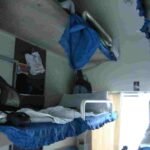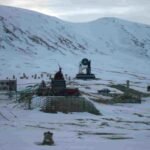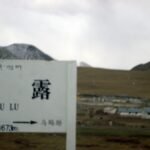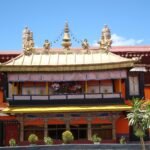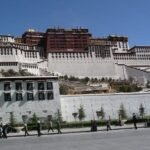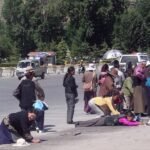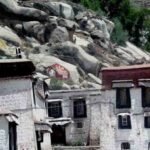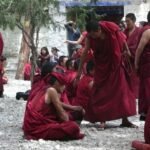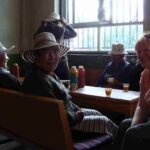Two Backpacks
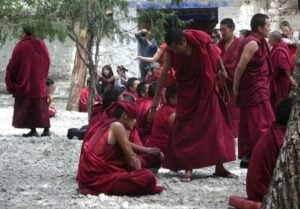
Chapter 8 - To the top of the world - Lhasa Tibet
We’re about to travel to the top of the world – to Lhasa, Tibet.
Our two-day journey will take us to nearly twelve thousand feet above sea level. Neither Ron nor I have experienced living at such height, but we’ve done our research; we have been taking aspirin for the last two weeks, said to thin the blood and help reduce the effects of altitude sickness. I just hope we’ve done enough.
Riots and unrest in March 2008 saw hundreds of Tibetan monks protest for the release of fellow Drepung monks. The protests, involving both monks and local Tibetans, became violent. Over one hundred and forty people died. The turmoil led to China closing the border with Tibet for twelve months before opening it again in April 2009.
So far, our destinations have been familiar, places I’ve visited or at least known how to get around. Our trip to Lhasa will be different. We’ve no idea what to expect or how welcome we will be.
Apple, the manager at our Beijing hostel, has worked miracles and obtained visas for Ron and me to travel to Lhasa by rail. To get our permits, we agreed to pay for a personal guide and stay in a government-approved hotel. These additional costs have knocked a hole in our seventy-dollar-a-day budget, but we’re determined to make the trip while the border remains open.
Our taxi drops us at Beijing West railway station; we take our turn in the queue and wait for security to inspect our bags. Inside, passengers wait patiently in a large central hall. It reminds me of the departure lounge of an airport.
Ron and I find two vacant seats and check the large electronic departure board – our train is on time. Pandemonium breaks out twenty minutes later when our gate is announced, and passengers rush towards the ticket barrier.
‘Let’s hang back until it dies down a bit,’ suggests Ron, eyeing the melee as hard-pushed railway staff check passengers’ tickets.
‘We can’t wait, Ron. Let’s go!’ I insist, worried we only have ten minutes to get onto the platform and find our carriage before the train’s departure.
We channel our inner Chinese personas, pick up our bags and push our way through the crowd. Once our tickets are stamped, we take the stairs to the platform below. Checking the carriage numbers, we find ours is at the far end of the train.
‘We’ve got a bit of a trek! We’re down that way,’ I tell Ron, indicating towards the back of the train, one of the longest I’ve seen.
‘Bloody typical,’ mumbles Ron as he grabs my backpack in his free hand. ‘Come on. Let’s go,’
I take his smaller bag and sling it over my shoulder. We set off along the platform as fast as our sixty-year-old legs allow. Our carriage, two from the end of the train, is already packed by the time we climb onboard. Our fellow travellers are somewhat perplexed by the arrival of two loawai (foreigners) travel companions. A couple give us a nod, while others ignore us and go about their business of settling into their beds for the night.
The carriage has eight sections with six bunks in each; the beds don’t fold, so the bottom bunks become communal seats during the day. If the occupants aren’t prepared to share, then passengers have to stand or, if quick enough, grab one of the fold-down seats in the corridor.
At nine-thirty, the train begins its journey north and quickly picks up speed. Tired from the day’s exertions, Ron clambers up onto the top bunk while I wedge myself into the middle one.
My bed is already made for the night with two clean white sheets, a blanket and a pillow. I’m sharing a compartment with four strangers, so there’s no way I’m stripping down to my underwear. I opt for a comfy T-shirt and loose fitting tracky-pants.
Any thought of reading for a while disappears when the lights go out at ten o’clock. Everyone quickly settles for the night; the only sounds are the rattling of the train and snoring from nearby passengers.
Xi’an is our first stop in the morning. Rubbing the sleep from my eyes, I glance at my watch, amazed that it’s six-thirty and I’ve slept through the night. Passengers depart, replaced by others, chatting and smiling.
The toilet facilities on our train are awful, as we discover after leaving Xi’an. The last section of the carriage provides two squat toilets. The toilet seats balance precariously on a raised platform with holes cut into the carriage floor, the track visible below. In this situation, aim is everything! There is also a long communal washbasin in which floats all manner of unidentifiable debris. I’m glad I had the forethought to bring wet wipes on the trip!
At our next station stop, I see the toilets being hosed down and cleaned, something I discover happens at every stop. From then on, Ron and I make a point of visiting immediately after the train leaves a station!
During our first full day’s travel, Ron and I manage to secure two seats in the corridor. We spend most of the time gazing at the ever-changing scenery that flashes by our fast-moving train. Distant mountains, grey slate-coloured rivers and enormous dams are so different to the China I experienced while living in Qinhuangdao.
Tea trollies pushed by sour-faced rail personnel appear regularly throughout the day, offering hot water for those who had the forethought to bring fresh tea. Hot snacks – the origins of which are highly dubious – nuts and bao buns are also for sale. But we’ve come prepared! We’ve got a large bag filled with cheese, biscuits, crackers, fruit and Danish pastries, plus a couple of large bottles of water.
With each passing hour, we climb higher. After another good night’s sleep, the rickety rack of the train proving soporific, we wake to an entirely different grey, snowy vista. Gone are the green hills and valleys, replaced by a snowscape that extends as far as the eye can see. Although the carriage is warm, I shiver and rummage in my bag for a thick sweater.
‘Morning! What’s for breakfast?’ Comes a voice from the bunk above.
‘Same as yesterday,’ I reply with a laugh, knowing Ron’s just as aware as I am of what’s left of our rations.
We stop at Gu Lu station and see a sign stating we’re 15,000 feet (4673 metres) above sea level, and we’re still climbing!
Snow lands give way to sparse grasslands that feed yak, sheep and deer; we’re in permafrost country. The rocky ground stretches for miles with distant outcrops of reddish grey standing against leaden skies.
In the distance, we see the construction of another rail line where workers toil in the snow flurries and biting winds. Intermittently, we pass tented camps that appear to provide little shelter from the severe weather.
In the late afternoon, the scenery changes once more; there’s snow on the ground again. We begin to see more Tibetan villages, single-storey brick buildings, their flat roofs adorned with bright, multi-coloured prayer flags, in sharp contrast to the snowy grey of the land.
Our train pulls into Lhasa station at seven in the evening. We go through the usual passport checks and exit into the arrival hall, where our Chinese guide, Peter, is waiting to greet us.
He welcomes us to Lhasa in excellent English and gives us both a khata, a white polyester scarf, and a traditional Tibetan welcome.
‘I hope you have an enjoyable stay. I’m at your service while you are here.’
It sounds to me as if he’s learned his lines well.
‘I wonder what he’d do if I asked him for a cheese toastie?’ I whisper to Ron. We smile, convinced Peter would be completely flummoxed if we strayed from the English he’d learned by rote.
Besides having a guide, we also have a driver to take us to our hotel. On the way, I get my first glimpse of the Potala Palace. In the fading evening light, it stands proud and tall above the city as if making one last stand against the Chinese push to eradicate Tibetans and their way of life. I squeeze Ron’s hand – I’m finding it hard to contain my excitement at finally being in Lhasa.
We travel for what seems like miles and eventually pull up at a hotel on the city’s outskirts. It’s not the hotel Apple booked for us; I’d written the details in my notebook, along with the Mandarin translation.
‘This isn’t our hotel, Peter. Why have you brought us here?’ I ask, feeling slightly uneasy.
‘Your booking has changed. You will like this hotel; it is very comfortable,’ insists our guide.
I have my doubts, but it’s getting late, and Ron and I both want to shower and relax for the night. Peter checks us in and shows us to our room. There’s a double bed, a mirror on the wall, a few hooks with coat hangers dangling from them, and a tiny bathroom.
‘Stay calm,’ mutters Ron, seeing I’m not happy with the poorly equipped room. ‘Getting upset isn’t going to solve anything.’
He’s right. We’re both tired and in need of a good night’s sleep.
The following morning, after finding the restaurant only serves porridge and bread for breakfast, I insist Peter finds us alternative accommodation. After an hour’s haggling and a visit from Peter’s manager, we’re moved to a modern, well-equipped hotel in the city centre.
I’m happy, but Peter isn’t. I’ve complained, and that isn’t acceptable as far as he’s concerned. Two years of living in China has taught me the Chinese don’t like to lose face. For the sake of harmony and a successful trip, I make a mental note – be nice to Peter!
Having lost two hours changing hotels, we’re eager to go sightseeing. Our first stop is the Jokhang Monastery, a Buddhist temple in Barkhor Square, considered by Tibetans to be the most sacred and important temple in the country. Four stories tall, it’s a blend of Tibetan, Nepalese, Chinese and Indian influences; built in 647AD, the monastery has been rebuilt several times, so Peter tells us.
Its golden roofs glistening in the morning sunlight, are the first to catch the eye. In front of the monastery entrance, pilgrims prostrate themselves in prayer. A murmur of mantras and the whirring of spinning prayer wheels fill the air around us.
We climb to the temple’s rooftop and have a spectacular view of Lhasa, the Potala Palace in the distance and the intricate courtyards and walkways of Jokhang.
Ron and I follow Peter as he leads us through the dimly-lit religious chambers. He tells us of Songtsen Gampo, the founder of the Tibetan empire, and his bride, Princess Wencheng, a Chinese princess credited with bringing scientific and agricultural advances of the Tang dynasty to Tibet.
Before leaving, Peter leads us to a cavernous hall where intricate murals line the walls and a life-size statue of the twelve-year-old Jowa Sakyamuni stands. Ron and I stand in silence and watch pilgrims pay homage to this sacred Buddha, captivated by the mystical beauty that surrounds us.
Our visit to the Norbulinka Palace, the traditional summer residence of the Dali Lama, is cut short. The altitude is beginning to affect Ron and me; we’re feeling light-headed and unsteady on our feet.
‘There’s a small café near the entrance to the Potala Palace. You can rest there and try our yak milk tea,’ Peter suggests.
Any chance to sit down for a while is welcome, so we happily agree and follow our guide. We cross a wide square and stop outside a rickety shack. I glance at Ron, concerned that we may be making a mistake. But Ron gives me a smile of encouragement, and when Peter pushes the door open, we step inside.
As we enter the large, dimly lit room, its occupants fall silent. Everyone turns to stare as Ron, and I edge our way past occupied tables towards two vacant chairs on the far side of the room. I smile at our fellow tea drinkers and receive a few toothless smiles in return. Once seated, conversations begin again, and the café’s occupants resume sipping their teas.
We’re sharing a table with six older Tibetans, the women in straw hats of different sizes and colours, the men in trilby-style hats or baseball caps.
‘Sweet or sour?’ asks Peter.
At first, I’ve no idea what he’s talking about, but it’s obvious he’s waiting for an answer. One of the older women at our table points to her glass of yak milk. The penny drops!
‘One of each,’ I reply, thinking I can offload the one I don’t like onto Ron.
Peter returns and places our small glasses of tea on the table. I can feel everyone watching, waiting for my reaction as I lift the glass of sweet milk tea to my lips and take a sip. It’s delicious, with a sweet musky taste. I smile and give a thumbs-up; everyone begins to clap. I’m so embarrassed. Then it’s Ron’s turn; he gets the same response. We both relax and try to talk to our companions with Peter’s help; there’s much laughter and giggling around us as Peter translates our answers to their inquisitive questioning.
Feeling refreshed, we set off once more, but the altitude quickly affects us again. We’re forced to forego our plans to climb to the imposing Potala Palace, its white and red façade in stark contrast to the backdrop of snow-covered mountains surrounding the city.
Instead, we slowly stroll around the square, watching pilgrims as they make their way to the base of the Potala Palace, the centre of their religion. Many have prayer wheels which they turn as they walk; others go through a ritual – three steps, then with hands together in prayer, they touch their head, lips and body before dropping to their knees and then prostrating themselves before standing and beginning the ritual once more.
It’s another glorious day. Peter is waiting for us as we exit the hotel. We’re not allowed to venture from our hotel without him; I’m not sure what the consequences would be if we tried.
‘We go to Bakhor Street this morning,’ pronounces Peter giving us both a smile.
I remember my vow to be pleasant. ‘That sounds great. Lead the way,’ I respond, returning his smile.
Bakhor Street reminds me of Kuta, Bali or the Khaosan Road in Bangkok, with hundreds of small stalls selling local souvenirs.
On the rooftops, armed soldiers perch, watching the ebb and flow of tourists and pilgrims as they stroll from one stall to another.
I’m an explorer! I love to wander down narrow streets and peer through open doorways, not in a creepy way, but to discover how people live and see a town’s ‘real’ life.
‘Let’s go this way!’ I insist when I see a lane running at right angles from the main thoroughfare. It’s a narrow strip of concrete set between two lines of identical houses with stalls set in the doorways. Here it’s not trinkets the vendors are selling but foodstuffs. I wander from one booth to another, intrigued at the vast array of spices, dried fish, meat and unidentifiable small carcases.
Ron is by my side when Peter grabs my arm. ‘This is not permitted! You must come back onto the main road. Now!’ he insists, pulling me back towards the main thoroughfare.
Ron’s having none of it. ‘Oy! That’s enough. Let her go!’ he insists, his Scottish brogue even broader when angry.
I’m sure Peter hasn’t understood a word Ron has said since our first meeting, but he clearly understands Ron’s tone and quickly releases my arm.
‘It’s not allowed! You must keep to the main thoroughfare! There are soldiers everywhere. Not good for you or me if you’re arrested,’ Peter states, as he glances around as if expecting someone to seize us at any moment.
‘Better do as he says,’ suggests Ron. ‘We don’t want to end up in jail, especially not here!’
Reluctantly, we retrace our steps.
Our afternoon trip is to the Sera Monastery, famous for its debating monks. I’d seen a television documentary on the history of the monastery years before. The images remained with me. The programme inspired me to make the trip.
We arrive early and wander along white-painted, stone-built pathways towards the Central Hall. We pass the monks’ living quarters along the way, many in disrepair with broken windows, dilapidated brickwork, and damaged doors.
The Central Hall is dimly lit, the air musty with incense. Colourful prayer flags hang from the rafters and windows; yak butter lamps burn around various statues. An enormous two-storey statue of Jampa dominates the room; one of the older, more senior monks seated close by intones prayers, his voice deep and melodic.
The monks, in red tunics, sit in rows, cross-legged on the floor. It’s lunchtime. We watch as servers walk between the rows, placing a small piece of sampa dough into the hands of each monk. Another follows close behind, ladling a watery soup into each monk’s bowl. When finished, fingers and bowls are licked clean, and then, as a single bell rings, the monks rise as one and walk from the hall. It’s nearly three o’clock; the debates are about to begin.
Peter guides us to a rocky white-walled area, where gnarled trees give shade from the afternoon’s sun; a few threadbare cushions lay scattered beneath their branches. I count over fifty monks gathered in groups around the courtyard.
‘Can you explain what’s happening?’ I ask Peter.
Peter is happy to oblige. ‘The monks use the debating process as a means of learning. The debate opens with an invocation to Majusri Buddisattva. One monk in each group stands and asks his question. He emphasises a point by stomping his foot or clapping his hands. His question must be answered quickly. During the debate, monks are only allowed to answer “Yes”, “No”, or “Uncertain”.
Ron and I watch on, fascinated, as some debates become heated while others appear more light-hearted, with smiles and laughter from monks nearby. I wonder how many of their numbers are missing after the murderous riots the year prior.
When we leave an hour later, the monks are still there. We have taken so many photos of Lhasa, the monks and the Tibetan people and have memories that will remain with us forever.
Tomorrow, we leave for Xi’an. The altitude has restricted our plans, but we’ve no regrets. We made it to the top of the world!
